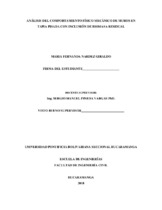Mostrar el registro sencillo del ítem
Análisis del comportamiento físico mecánico de muros en tapia pisada con inclusión de biomasa residual
| dc.contributor.advisor | Pineda Vargas, Sergio Manuel | |
| dc.contributor.author | Nardez Giraldo, María Fernanda | |
| dc.coverage.temporal | 2018 | |
| dc.date.accessioned | 2020-06-18T14:52:42Z | |
| dc.date.available | 2020-06-18T14:52:42Z | |
| dc.date.issued | 2018 | |
| dc.identifier.uri | http://hdl.handle.net/20.500.11912/5617 | |
| dc.description | 111 páginas | spa |
| dc.description.abstract | La eficiencia energética se ha convertido en una tendencia creando hábitos culturales y generado inversiones a niveles tecnológicos, buscando una reducción de consumo de energía en las actividades que realiza el ser humano. La construcción es una de estas actividades que junto con la industria genera altos consumos de energía, siendo la segunda la generadora de insumos para el sector construcción, ya que en Colombia los sistemas constructivos más utilizados como la mampostería confinada, necesitan de procesos industriales donde la materia prima se transforma usando energía y produciendo emisiones de CO2. Por este motivo se deben considerar sistemas de construcción alternativos, donde los materiales a utilizar ayuden a disminuir estos indicadores. La tapia pisada es una alternativa de construcción de viviendas que genera ahorro en todas las tres etapas en las que se producen consumos energéticos: en la manufactura de materiales, construcción y operación. Esta investigación se enfoca en la etapa de operación, donde los consumos se generan por el uso de aparatos, normalmente eléctricos, para crear ambientes de confort dentro de las viviendas, los cuales pueden ser omitidos en las construcciones de tapia pisada gracias a las propiedades de absorción-transpiración que regulan el comportamiento térmico dentro de la misma. Se analizó aquí entonces, el comportamiento físicomecánico del material que compone los muros de tapia pisada incluyendo biomasa residual en diferentes porcentajes, realizando ensayos de compresión simple y conductividad térmica para identificar la relación del porcentaje de participación de la biomasa en el comportamiento estructural y térmico del muro. Se encontró que a mayor porcentaje de biomasa la capacidad de carga inicialmente mejora y el nivel de aislamiento térmico aumenta. Sin embargo, el material pierde cohesión, forma y homogeneidad. | spa |
| dc.description.abstract | Energy efficiency has become a trend creating cultural habits and generating investments at technological levels, seeking a reduction of energy consumption in the activities carried out by the human being. Construction is one of these activities that together with the industry generates high energy consumption being the second the generator of inputs for the construction sector since in Colombia the most used construction systems such as confined masonry, need industrial processes where the raw material is transformed using energy and producing CO2 emissions. For this reason, alternative construction systems should be considered where the materials to be used help to reduce these indicators The stepped wall is an alternative to housing construction that generates savings in all three stages in which energy consumption occurs' in the manufacture of materials, construction and operation Thrs research focuses on the stage of operation, where consumption is generated by the use of appliances usually electrical to create comfort environments wrthin homes, which can be omitted in the construction of footprints thanks to the properties of absorption-transpiration that regulate the thermal behavior within it. The physical-mechanical behavior of the material composing the stepped wall walls including residual biomass in different percentages was analyzed here performing simple compression tests and thermal conductivity to identify the ratio of the percentage of participation of the biomass in the structural behavior and thermal of the wall It was found that the higher the percentage of biomass the load capacity initially improves and the level of thermal insulation increases However the material loses cohesion form and homogeneity | eng |
| dc.format.mimetype | application/pdf | |
| dc.language.iso | spa | |
| dc.publisher | Universidad Pontificia Bolivariana | spa |
| dc.rights | Attribution-NonCommercial-NoDerivatives 4.0 International | * |
| dc.rights.uri | http://creativecommons.org/licenses/by-nc-nd/4.0/ | * |
| dc.title | Análisis del comportamiento físico mecánico de muros en tapia pisada con inclusión de biomasa residual | spa |
| dc.type | Trabajo de grado | spa |
| dc.publisher.department | Escuela de Ingenierías | spa |
| dc.publisher.program | Ingeniería Civil | spa |
| dc.type.hasVersion | publishedVersion | spa |
| dc.description.sectional | Bucaramanga | spa |
| dc.description.degreename | Ingeniero Civil | spa |
Ficheros en el ítem
Este ítem aparece en la(s) siguiente(s) colección(ones)
-
Trabajos de grado [6698]
Monografías, artículos, informes, proyecto de grado


